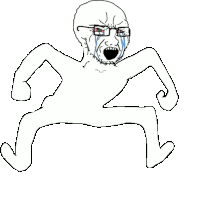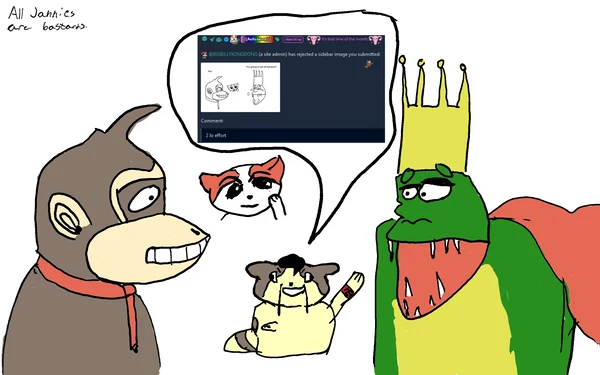- 14
- 34
worst i've ever seen it is it just edgier /r/politics now or something
- 4
- 9
🚨LEAKED🚨
— Nick O’Neill (@chooserich) February 6, 2025
Full @HalieyWelchX Talk Tuah Episode with @Banks
Hawk Tuah finally wakes up!
00:00 INTRO
00:40 HALIEY MESSED UP
2:26 HALIEY’S OFFICIAL STATEMENT
4:00 ALL OF HALIEY’S INCOME FROM THIS EP IS GOING TO ANIMAL CHARITIES
5:00 BEHIND THE SCENES OF $HAWK COIN LAUNCH… pic.twitter.com/PZpbREnQng
Someone watch this and summarize it pls I can't stand her accent
- 70
- 55
Subway just released a footlong Oreo cookie. pic.twitter.com/cPI17yULLH
— FearBuck (@FearedBuck) February 4, 2025
- 12
- 27
- 52
- 131
76 percent of British converts to radical forms of Islam are ginger. pic.twitter.com/DVa3KGUzXy
— Visegrád 24 (@visegrad24) February 1, 2025
Muhammad had a red beard, it's the religion where gingers can be the main character.
Hollywood jews replaced all the gingers with blacks so they had to retaliate
- 5
- 28
Limit social media consumption as much as possible, but recognize that you cannot eliminate it altogether
Based and actually great advice 
Pay attention to the comments you make about your own bodies in front of your children and the attitudes toward exercise and food you're displaying. Be mindful of the kinds of messages your kids are getting from their entertainment and social media activity.
Don't shame your kids for eating an entire box of Swiss Rolls, chud 
Comment sections also expose posters and viewers to harsh critiques about people's bodies, which can fuel more insecurity and low self-esteem.
Very interesting how wanting to work out and feel better  is a harmful social contagion
is a harmful social contagion  but
but  ing out
ing out  absolutely is not
absolutely is not 
- 23
- 57
I couldn't even tell you the names of any of them. I've never even played as Donkey Kong in Smash or Mario Kart because he's the BIPOC of the Mario universe and sucks.
Carp doesn't want you to know this, but this is what Donkey Kong actually looks like
We should get rid of Donkey Kong December. We should get rid of White Women Wednesdays and just have Wario Wednesdays instead. Look at him
- 7
- 47
During their meeting, Netanyahu gifted Trump a golden and a regular pager.
— Open Source Intel (@Osint613) February 5, 2025
Trump reacted: “That operation against Hezbollah was incredible.”
😂😂😂 pic.twitter.com/MnvC5vc8jl
- 12
- 42
- 66
- 115
According to reddit: he doesn't deserve this neurodivergent bacterial vaginosis scented TSA queen.
https://old.reddit.com/r/Denver/comments/1e8ehfd/i_know_this_is_a_long_shot_but_if_you_were_dinger/
Don't take this the wrong way— Do you actually look like your photos? Or are they a collage of you on your best day, and not rooted in reality?
I've walked out on dates. It's almost 100% of the time because the person misrepresented themself in some way. Maybe they hid something obvious. Maybe they were in denial about aging or weight fluctuation. He could have also built you up in his mind into someone you're not, and then panicked when he was met with reality (this has also happened to me) Who knows. But yea, for leaving after 5 mins, I'm guessing it had to do with an unmet expectation.

- 4
- 12
- 12
- 19
- 9
- 45
- 9
- 22
This all started when someone slandered the queen, AOC, implying that she is part of the 1% she claims to fight. She then proceeds to post the massive L that despite making $174k/year (before bribes) she doesn't own a house and still has unpaid student loans  Of course this leads the fans of known peepee sucking s*x pest, Destiny, to defend their queen's honor by being anti-freedom communists.
Of course this leads the fans of known peepee sucking s*x pest, Destiny, to defend their queen's honor by being anti-freedom communists.
You don't stop it, X is made for this, to push out anything Elon wants, playing with the algorithm to push out fake shit and suppress real things, it's the easiest shit in the world, I bet if I had access I could code the inverse in less than a day.
I wonder if he held this position before Elon bought it… 
We're fricked. The last 9-ish years have shown us that something like 80% of the population can be fully fricking brainwashed by propaganda of one form or another; and we haven't figured out a way to counter, stop, or correct it.
No one is immune to propaganda. That's why it's been utilized since the dawn of humanity and will continue until the end of it.
And our national worship of "free speech" has been perverted to mean we have a right to be constantly be lied to.
We should definitely just give the good guys, who never lie, complete and total control over all facts. Surely they would never abuse that power 
this would require government intervention to counter, but republicans love fomenting propaganda because they hate america, and democrats will never take steps against social media contagion because they're weak, effete cowards obsessed with protecting land grants and trans visibility, not protecting voting rights or america's institutions.
Please daddy government! Censor these filthy liars! Wait… I'm not a liar! Don't censo… ACK! 
You want to silence people from making up blatant lies? That's what free speech is there to protect bro! That's dictatorship to be anti-lies!!
Freedom hating communist wishes we had a ministry of truth. 
I've been wondering why tiny's been so chill with everything going on, and then remembered people on this media diet will only realize it's all fake after things get much worse. I just fear whatever the tech bros are doing will be woefully stupid, even more so that what Donald has in mind.
This "Tiny" he's referring to is the streamer, Destiny, who recently got in hot water after sharing a bunch of videos of himself banging both men and women with his groomercord friends. This led to them being leaked and him being sued by one (or maybe multiple) of the women from the leaks. Additionally all of his former streaming partners have distanced themselves from or completely abandoned him. The reason he has been "chill" is because he is laying low because he knows he's fricked. And this redditor gets all of his opinions from this man. Just remember if you're ever feeling low, you will never be as pathetic as someone like this 
I know Americans don't like this with the 1st amendment and all, but at what point do you allow this to continue happening? Maybe it should just be illegal to tell blatant lies like this, but idk
Posts in /r/Vancouver. What do you know, a filthy foreigner with a negative opinion of the 1st amaendment! If I had a dollar for every time I heard that, I'd have more money than AOC!
Anyways, America has free speech and it's here to stay, no matter how much commies cry about it.



- 106
- 86
🇺🇸 The female Black Hawk helicopter pilot from the crash in Washington, Captain Rebecca Lobach, was not named until her social media was cleaned … so it seems.
— Lord Bebo (@MyLordBebo) February 2, 2025
She was Biden’s aide. pic.twitter.com/gP16Tmr2py
- 98
- 62

 pretend this is a huge deal and it means he's gonna get rid of medicaid next.
pretend this is a huge deal and it means he's gonna get rid of medicaid next.  say there will be backlash when
say there will be backlash when  realize theyve been duped now that they heckin' wholesome random money for other countries fund and more tacpayer dollars will go to domestic issues! Noooo
realize theyve been duped now that they heckin' wholesome random money for other countries fund and more tacpayer dollars will go to domestic issues! Noooo 
https://old.reddit.com/r/news/comments/1igk9s8/elon_musk_says_usaid_is_beyond_repair_and_he_is/
edit: he needs to be heckin prosecuted and charged with treason 
https://old.reddit.com/r/politics/comments/1igpcas/musk_im_closing_entire_federal_department_down/
- 13
- 39
I do not take the Instagram seriously, but its funny to see the slow gather of momentum!
- 4
- 23
- 8
- 19
- 45
- 22
I kinda hate rationalists but I haven't heard a convincing counter argument on AI doom.
- 26
- 82
I'm not filling the silence, I'm not starting the conversation, and I don't ask his opinion on anything. We sat in silence for 25 minutes before a live show this weekend because I didn't carry the conversation singlehandedly. When he speaks to me, I always respond and keep the conversation going as long as he does. I don't ask him his opinion, though, and I'm not letting a lack of knowledge on a subject deter me from sharing my opinions. Woo!

Imagine talking so much that not doing so actively increases the amount of free time you have.
Edit: Ofc she's a 

Now playing: Northern Hemispheres (DKC).mp3





















 House boomer
House boomer  | Discordmisic
| Discordmisic 
 |
|
 Absolutely not say Huffpo journos; it's actually very medically dangerous and problematic
Absolutely not say Huffpo journos; it's actually very medically dangerous and problematic 












 Bibi gifted Trump two pagers, a golden one
Bibi gifted Trump two pagers, a golden one  and a normal one
and a normal one 












































 says USAid is 'beyond repair'
says USAid is 'beyond repair'  and he is working to shut it down
and he is working to shut it down 
























